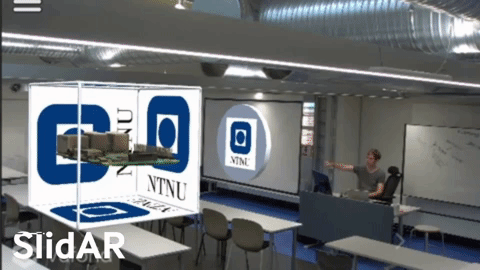Transforming Classroom Presentations with Augmented Reality: The first steps of the SlidAR Journey
In recent times, technology has permeated every aspect of our lives, reshaping the way we communicate, learn, and even teach. One of the burgeoning technologies leading the charge is Augmented Reality (AR), which offers a seamless amalgamation of digital elements into our world, enhancing the learning experience manifold. Venturing into this transformative tech-scape, I experimented with integrating AR into classroom presentations, breathing a new dimension of life into the traditional slide format.
Here, I share my firsthand experience and insights from introducing a classroom-sized AR system into my presentation using my SlidAR prototype.
The AR Experience
SlidAR transformed the traditional 2D slides into a 3D experience, allowing us to inspect and interact with the content in an entirely new way. Each element popped with a vibrancy that was not just visually enticing but also intellectually stimulating. SlidAR allowed us to inspect various components of the Raspberry Pi closely, offering a visual experience that transcended the conventional presentation boundaries.
Navigating the Challenges
However, this journey was not without its hurdles. Here, I outline some of the challenges encountered during the prototype testing and how they can be seen as opportunities for refinement:
The Invisible Interface
Like a weather forecaster standing in front of a green screen, the lecturer cannot see the content without wearing a head-mounted display (HMD). Wearing such a device during a lecture is, for now, inconvenient and uncomfortable. Operating in an augmented space, it is challenging to gauge the exact location of the digital elements. This hurdle hints at the necessity for the development of tools or indicators that can help the presenter navigate the AR space with precision.
Dependence on the Control Monitor
The control monitor became my constant reference point to ensure synchrony between my movements and the digital renderings. This reliance, however, sometimes created a disconnect, as it diverted my focus from the audience. In the future, integrating more intuitive controls and feedback mechanisms would facilitate a smoother, more engaging presentation style.
Image Tracking Glitches
The AR system was not immune to glitches, particularly in image tracking. Issues such as poor contrast between the projector and the blackboard, inadequate lighting in the classroom, distortion of the image marker due to non-straight camera angles, and the loss of feature points (when the lecturer inadvertently covers the target with their body) can all contribute to glitches and the loss of the 3D content, which can negatively impact the user experience (UX).
Looking Ahead
Despite these challenges, the prototype served as a testament to AR's potential in transforming educational spaces. The added dimension and 'coolness' factor cannot be understated, offering a fresh, interactive avenue to explore academic content.
As we forge ahead, focusing on refining the AR technology to create a seamless, immersive, and interactive learning environment will be paramount. The goal is to foster a space where both educators and students can explore, learn, and grow together, bridging the gap between the physical and digital worlds with ease.
AR presentations, classroom innovation, immersive learning
